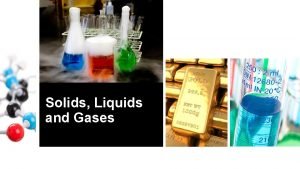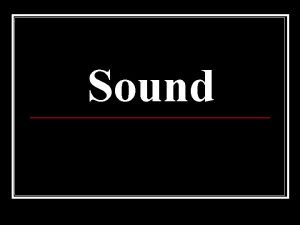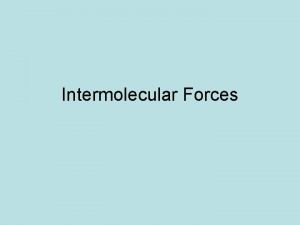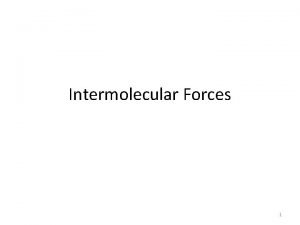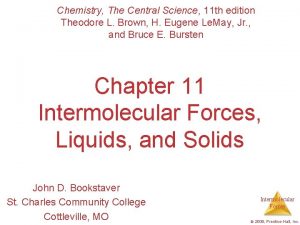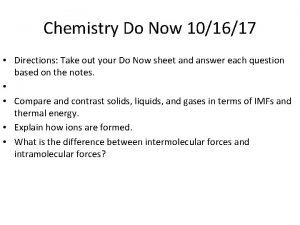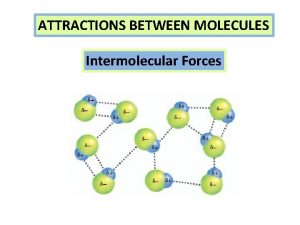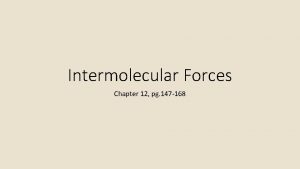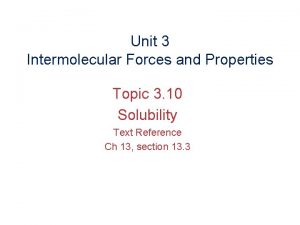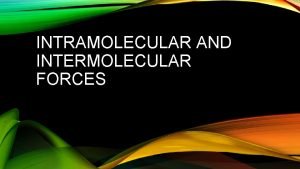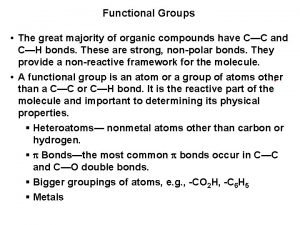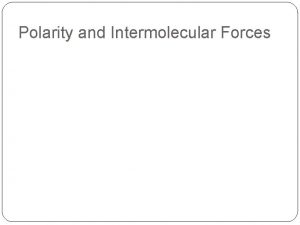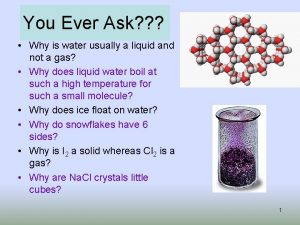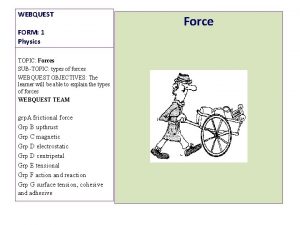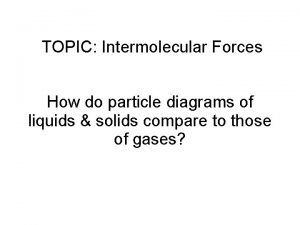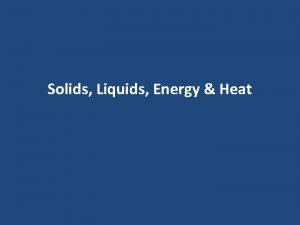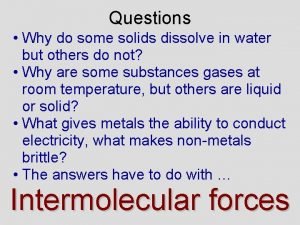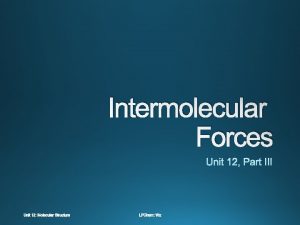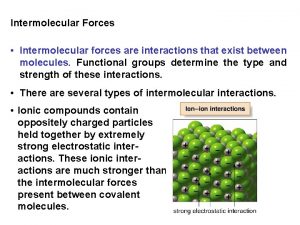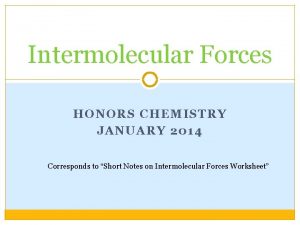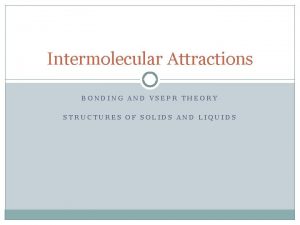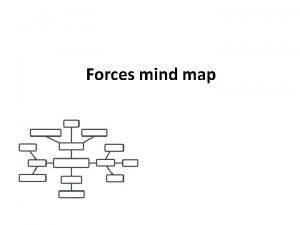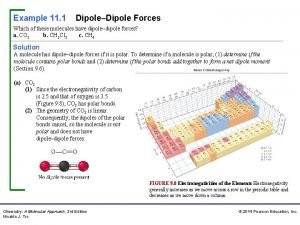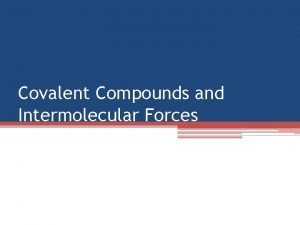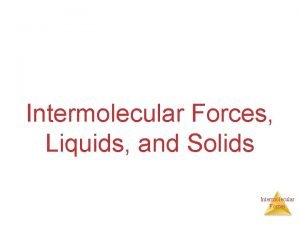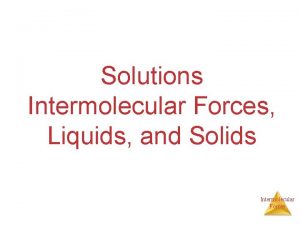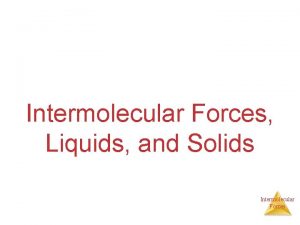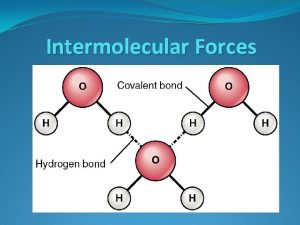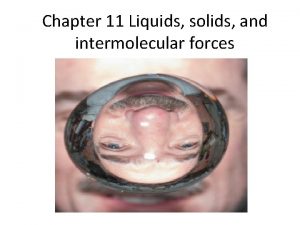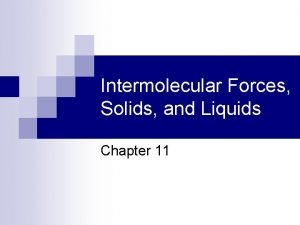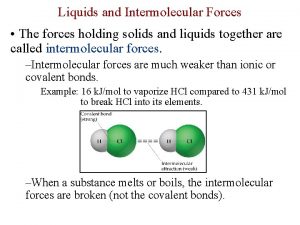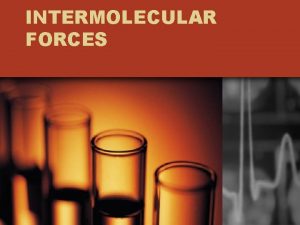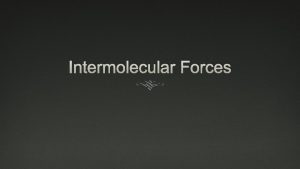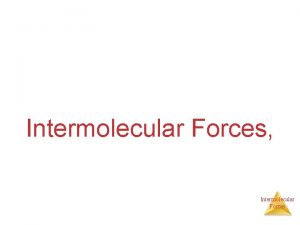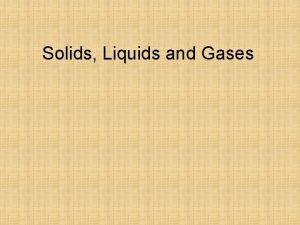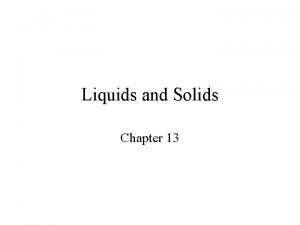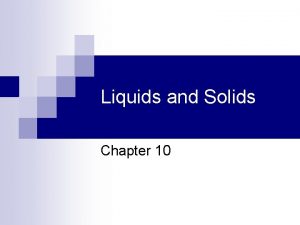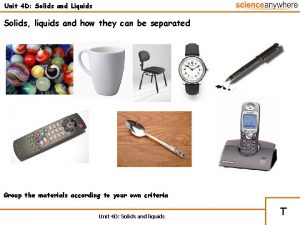Liquids and Solids 10 1 Intermolecular Forces 10





















































- Slides: 53

Liquids and Solids 10. 1 Intermolecular Forces 10. 2 The Liquid State 10. 3 An Introduction to Structures and Types of Solids 10. 4 Structure and Bonding in Metals 10. 5 Carbon and Silicon: Network Atomic Solids 10. 6 Molecular Solids 10. 7 Ionic Solids 10. 8 Vapor Pressure and Changes of State 10. 9 Phase Diagrams

Intramolecular Bonding • Force “within” the molecule. • Molecules are formed by sharing electrons between the atoms. • The bond strength determine molecular stability and reactivity of the molecule.

Intermolecular Forces • Forces that occur between molecules. § Dipole–dipole forces Ø Hydrogen bonding § London dispersion forces • Intermolecular forces are weaker than intramolecular bonds. • The strength of intermolecular forces influence physical properties of substances.

Hydrogen Bonding in Water • Blue dotted lines are the intermolecular forces between the water molecules.

Concept Check Which are stronger, intramolecular bonds or intermolecular forces? How do you know?

Phase Changes • When a substance changes from solid to liquid to gas, the molecules remain intact. • The changes in state are due to changes in the forces among molecules rather than in those within the molecules.

Phase Changes • Solid to Liquid § As energy is added, the motions of the molecules increase, and they eventually achieve the greater movement and disorder characteristic of a liquid. • Liquid to Gas § As more energy is added, the gaseous state is eventually reached, with the individual molecules far apart and interacting relatively little.

Schematic Representations of the Three States of Matter


Densities of the Three States of Water

Dipole-Dipole Forces • Dipole moment – molecules with polar bonds often behave in an electric field as if they had a center of positive charge and a center of negative charge. • Molecules with dipole moments can attract each other electrostatically. They line up so that the positive and negative ends are close to each other.

Dipole-Dipole Forces • Dipole-dipole forces – about 1% as strong as covalent or ionic bonds – become weaker with distance – unimportant in the gas phase

Dipole-dipole Attractions

Dipole-Dipole Forces

Hydrogen Bonding • Strong dipole-dipole forces. • Hydrogen is bound to a highly electronegative atom – nitrogen, oxygen, or fluorine.

Hydrogen Bonding

Hydrogen Bonding • H-bonding has a very important effect on physical properties – For example, boiling points are greater when H-bonding is present • Very strong due to – great polarity of the bond between H and the N, O or F – close approach of the dipoles due to H’s small size

London Dispersion Forces • aka Van der Waals forces • Nonpolar molecules must exert some kind of force or they would never solidify

London Dispersion Forces • London dispersion forces (LDF) – due to an instantaneous dipole moment • created when electrons move about the nucleus • a temporary nonsymmetrical electron distribution can develop (I. e. , all the electrons will shift to one side of the molecule)

London Dispersion Forces • The instantaneous dipole moment can induce an instantaneous dipole moment in a neighboring molecule, which could induce another instantaneous dipole moment in a neighboring molecule, etc. (like a “wave” in the stands of a football game)

London Dispersion Forces • The LDF is very weak and short-lived • To form a solid when only LDF exists requires very low temperatures – the molecules or atoms must be moving slowly enough for the LDF to hold the molecules or atoms together in a “solid” unit

London Dispersion Forces • Element Helium Neon Argon Krypton Xenon Freezing Point (o. C) -269. 7 -248. 6 -189. 4 -157. 3 -111. 9

London Dispersion Forces • Notice that as the MM of the noble gas increases, the freezing point increases – This implies that the LDF between the atoms is stronger as the MM increases • Large atoms with many electrons have an increased polarizability (the instantaneous dipole would be larger), resulting in a larger London Dispersion Force between the atoms than between smaller atoms

London Dispersion Forces • Instantaneous dipole that occurs accidentally in a given atom induces a similar dipole in a neighboring atom. • Significant in large atoms/molecules. • Occurs in all molecules, including nonpolar ones.

London Dispersion Force

London Dispersion Forces

Melting and Boiling Points • In general, the stronger the intermolecular forces, the higher the melting and boiling points.

The Boiling Points of the Covalent Hydrides of the Elements in Groups 4 A, 5 A, 6 A, and 7 A

Concept Check Draw two Lewis structures for the formula C 2 H 6 O and compare the boiling points of the two molecules.

Concept Check Which molecule is capable of forming stronger intermolecular forces? N 2 Explain. H 2 O

Concept Check Which gas would behave more ideally at the same conditions of P and T? CO Why? or N 2

Liquids • Low compressibility, lack of rigidity, and high density compared with gases. • Surface tension – resistance of a liquid to an increase in its surface area: § Liquids with large intermolecular forces tend to have high surface tensions.

Liquids • Capillary action – spontaneous rising of a liquid in a narrow tube: § Cohesive forces – intermolecular forces among the molecules of the liquid. § Adhesive forces – forces between the liquid molecules and their container.

Convex Meniscus Formed by Nonpolar Liquid Mercury § Which force dominates alongside the glass tube – cohesive or adhesive forces? cohesive forces

Concave Meniscus Formed by Polar Water • Which force dominates alongside the glass tube – cohesive or adhesive forces? Adhesive forces

Liquids • Viscosity – measure of a liquid’s resistance to flow: § Liquids with large intermolecular forces or molecular complexity tend to be highly viscous.

Solids • Amorphous Solids: § Disorder in the structures § Glass • Crystalline Solids: § Ordered Structures § Unit Cells

Bragg Equation • Used to determine the interatomic spacings. n = integer = wavelength of the X rays d = distance between the atoms = angle of incidence and reflection

Bragg Equation

Types of Crystalline Solids • Ionic Solids – ions at the points of the lattice that describes the structure of the solid. • Molecular Solids – discrete covalently bonded molecules at each of its lattice points. • Atomic Solids – atoms at the lattice points that describe the structure of the solid.

Examples of Three Types of Crystalline Solids

Classification of Solids

Closest Packing Model • Closest Packing: § Assumes that metal atoms are uniform, hard spheres. § Spheres are packed in layers.

The Closest Packing Arrangement of Uniform Spheres • • aba packing – the 2 nd layer is like the 1 st but it is displaced so that each sphere in the 2 nd layer occupies a dimple in the 1 st layer. The spheres in the 3 rd layer occupy dimples in the 2 nd layer so that the spheres in the 3 rd layer lie directly over those in the 1 st layer.

The Closest Packing Arrangement of Uniform Spheres • abc packing – the spheres in the 3 rd layer occupy dimples in the 2 nd layer so that no spheres in the 3 rd layer lie above any in the 1 st layer. • The 4 th layer is like the 1 st.

Hexagonal Closest Packing (hcp)

Cubic Closest Packing (ccp)

The Indicated Sphere Has 12 Nearest Neighbors • Each sphere in both ccp and hcp has 12 equivalent nearest neighbors.

The Net Number of Spheres in a Face. Centered Cubic Unit Cell

Three Cubic Unit Cells and the Corresponding Lattices

Concept Check Determine the number of metal atoms in a unit cell if the packing is: a) Simple cubic b) Cubic closest packing a) 1 metal atom b) 4 metal atoms

Concept Check A metal crystallizes in a face-centered cubic structure. Determine the relationship between the radius of the metal atom and the length of an edge of the unit cell.

Concept Check Silver metal crystallizes in a cubic closest packed structure. The face centered cubic unit cell edge is 409 pm. Calculate the density of the silver metal. Density = 10. 5 g/cm 3
 Intramolecular forces
Intramolecular forces Difference between intramolecular and intermolecular
Difference between intramolecular and intermolecular Inter vs intramolecular forces
Inter vs intramolecular forces Thermal expansion and contraction examples
Thermal expansion and contraction examples Solids liquids and gases section 2 properties of fluids
Solids liquids and gases section 2 properties of fluids Kinetic molecular theory of solid
Kinetic molecular theory of solid Solid liquid gas particle diagram
Solid liquid gas particle diagram Venn diagram of solid and liquid
Venn diagram of solid and liquid Solid liquid and gas particles
Solid liquid and gas particles Process of liquid to gas
Process of liquid to gas Adhesive force
Adhesive force Liquids and solids menu
Liquids and solids menu Lesson outline lesson 1 solids liquids and gases answer key
Lesson outline lesson 1 solids liquids and gases answer key Chapter 14 solids liquids and gases worksheet answers
Chapter 14 solids liquids and gases worksheet answers Liquids and solids
Liquids and solids Particle movement in solids liquids and gases
Particle movement in solids liquids and gases How does sound travel through solids liquids and gases
How does sound travel through solids liquids and gases Properties of solid liquid and gas
Properties of solid liquid and gas Motion of particles in solids, liquids and gases
Motion of particles in solids, liquids and gases Chapter 11 - states of matter: liquids and solids
Chapter 11 - states of matter: liquids and solids Gas from becomes easier to compress
Gas from becomes easier to compress Theory of filtration
Theory of filtration The attractive force between water molecules
The attractive force between water molecules Geckos and intermolecular forces
Geckos and intermolecular forces Similarities of intermolecular and intramolecular forces
Similarities of intermolecular and intramolecular forces Viscosity and intermolecular forces
Viscosity and intermolecular forces Intermolecular forces capillary action
Intermolecular forces capillary action Molecular attractions
Molecular attractions Interatomic and intermolecular forces
Interatomic and intermolecular forces Unit 3 intermolecular forces and properties
Unit 3 intermolecular forces and properties Dipole induced dipole interaction
Dipole induced dipole interaction Electronegativity intermolecular forces
Electronegativity intermolecular forces Ion solvent interaction
Ion solvent interaction Polarity and intermolecular forces
Polarity and intermolecular forces Ch2cl intermolecular forces
Ch2cl intermolecular forces Webquest types of forces answers
Webquest types of forces answers Intermolecular forces
Intermolecular forces 3 types of intermolecular forces
3 types of intermolecular forces Types of intermolecular forces
Types of intermolecular forces How intermolecular forces affect solvation
How intermolecular forces affect solvation Induced dipole
Induced dipole Phthatic
Phthatic Intermolecular forces of formaldehyde
Intermolecular forces of formaldehyde Intermolecular forces symbol
Intermolecular forces symbol Dipole-dipole interaction example
Dipole-dipole interaction example Boiling point with intermolecular forces
Boiling point with intermolecular forces Van der waals attraction
Van der waals attraction Strongest to weakest intermolecular forces
Strongest to weakest intermolecular forces Strongest to weakest intermolecular forces
Strongest to weakest intermolecular forces Ch2cl intermolecular forces
Ch2cl intermolecular forces Example of ion dipole
Example of ion dipole Mind map forces
Mind map forces Ch2cl intermolecular forces
Ch2cl intermolecular forces Coh2 intermolecular forces
Coh2 intermolecular forces














